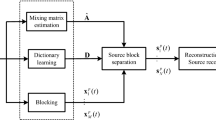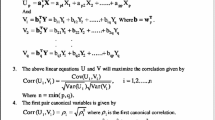Abstract
Speech process has benefited a great deal from the wavelet transforms. Wavelet packets decompose signals in to broader components using linear spectral bisecting. In this paper, mixtures of speech signals are decomposed using wavelet packets, the phase difference between the two mixtures are investigated in wavelet domain. In our method Laplacian Mixture Model (LMM) is defined. An Expectation Maximization (EM) algorithm is used for training of the model and calculation of model parameters which is the mixture matrix. And then we compare estimation of mixing matrix by LMM-EM with different wavelets. And then we use adaptive algorithm in each wavelet packet for speech separation and we see better results are obtained. Therefore individual speech components of speech mixtures are separated.
Similar content being viewed by others
References
Bell, A. J., & Sejnowski, T. J. (1995). An information-maximization approach to blind separation and blind deconvolution. Neural Computation, 7, 1129–1159.
Bilmes, J. A. (1998). A gentle tutorial of the EM algorithm and its application to parameter estimation for Gaussian mixtures and hidden mixture models (Technical Report). Dept. Elect. Eng. Comput. Sci., Univ. California, Berkeley, California.
Bofill, P., & Zibulevsky, M. (2001). Underdetermined blind source separation using sparse representation networks. Signal Processing, 81(11), 2353–2362.
Calamante, F., Mørup, M., & Hansen, L.K. (2004). Defining a local arterial input function for perfusion MRI using independent component analysis. Magnetic Resonance in Medicine, 52(4), 789–797.
Calhoun, V. D., Adali, T., Hansen, L. K., Larsen, J., & Pekar, J. J. (2003). ICA of functional MRI data: an overview. In Fourth international symposium on independent component analysis and blind source separation (pp. 281–288).
Cardoso, J.-F. (1998). Blind signal separation: Statistical principles. In Proc. IEEE (Vol. 86, pp. 2009–2025).
Comon, P. (1994). Independent component analysis—A new concept? Signal Processing, 36, 287–314.
Comon, P., & Mourrain, B. (1996). Decomposition of quantics in sums of powers of linear forms. Signal Processing, 53, 93–107.
Davies, M., & Mitianoudis, N. (2004). A simple mixture model for sparse overcomplete ICA networks. IEE Proceedings Vision, Image and Signal Processing, 151(1), 35–43.
Hermann, M., & Yang, H. (1996). Perspectives and limitations of selforganizing maps. In Proc. ICONIP’96.
Hyvarinen, A. (1998). Independent component analysis in the presence of Gaussian noise by maximizing joint likelihood networks. Neural Computation, 22, 49–67.
Karlsen, B., Sørensen, H. B., Larsen, J., & Jackobsen, K. B. (2002). Independent component analysis for clutter reduction in ground penetrating radar data. In Proceedings of the SPIE, AeroSense 2002 (Vol. 4742, pp. 378–389). Bellingham: SPIE.
Lee, T.-W. (1998). Independent component analysis: theory and applications. Boston: Kluwer.
Lewicki, M., & Sejnowski, T. J. (1998). Learning nonlinear overcomplete representations for efficient coding. In Advances in neural information processing systems (Vol. 10, pp. 815–821). Cambridge: MIT Press.
Lewicki, M., & Sejnowski, T. J. (2000). Learning over complete representations networks. Neural Computation, 12, 337–365.
Lewicki, M. S., & Sejnowski, T. J. (2009, to be published) Learning over complete representations, Neural Computation.
McKeown, M., Hansen, L. K., & Sejnowski, T. J. (2003). Independent Component Analysis for fMRI: What is Signal and What is Noise? Current Opinion in Neurobiology, 13(5), 620–629.
Mitianoudis, N. (2004). Audio source separation using independent component analysis. Ph.D. dissertation, Queen Mary, London, UK.
Tinati, M. A., & Mozaffari, B. (2005a). Comparison of time-frequency and time-scale analysis of speech signals using STFT and DWT. WSEAS Transaction on Signal Processing, 1(1), 11–16.
Tinati, M. A., & Mozaffari, B. (2005b). A novel method for noise cancellation of speech signals using wavelet packets. In 2005 Proc. 7th, int. conf. on advanced communication technology (Phoenix Park, Korea, 21–23 February 2005) (Vol. 1, pp. 35–38).
Zibulevsky, M., Kisilev, P., Zeevi, Y. Y., & Pearlmutter, B. A. (2002). Blind source separation via multimode sparse representation networks. Advances in Neural Information Processing Systems, 14, 1049–1056.
Author information
Authors and Affiliations
Corresponding author
Rights and permissions
About this article
Cite this article
Mozaffari, B., Tinati, M.A. An adaptive speech source separation algorithm under overcomplete-cases using Laplacian mixture modeling for mixture matrix estimation by adaptive EM-type algorithm in wavelet packet domain. Int J Speech Technol 11, 33–42 (2008). https://doi.org/10.1007/s10772-009-9033-9
Received:
Accepted:
Published:
Issue Date:
DOI: https://doi.org/10.1007/s10772-009-9033-9




